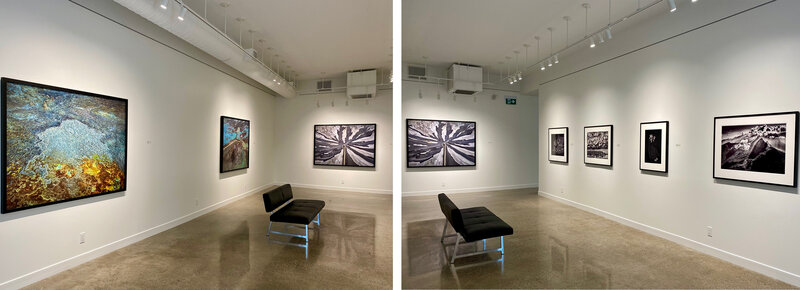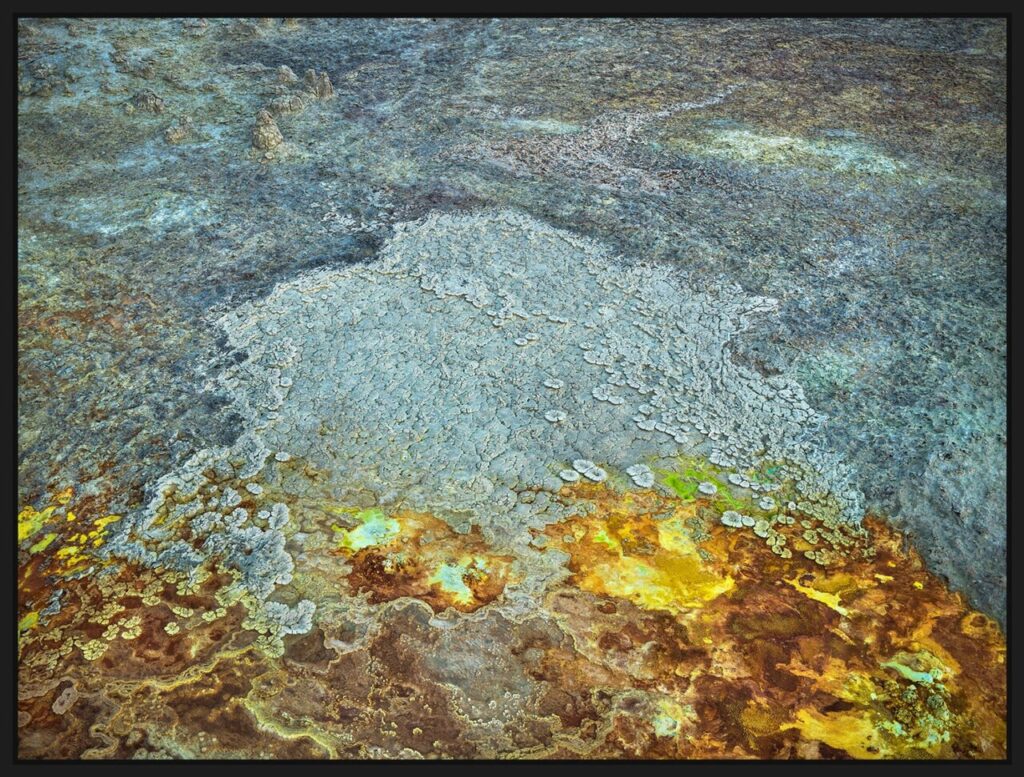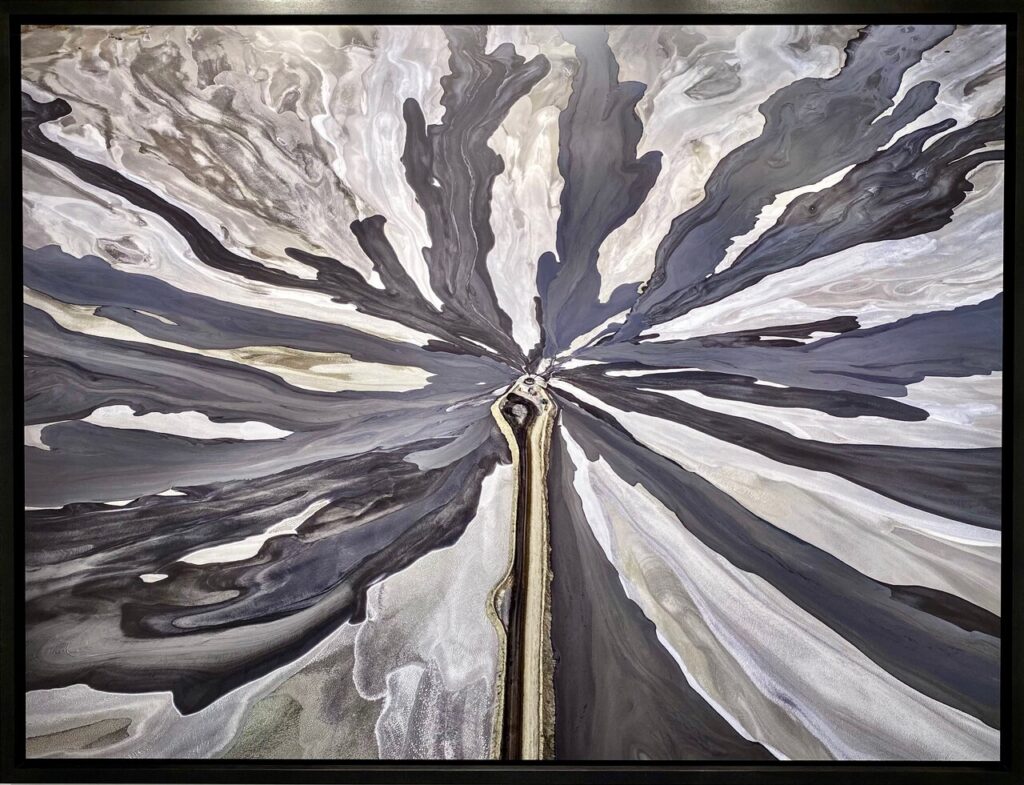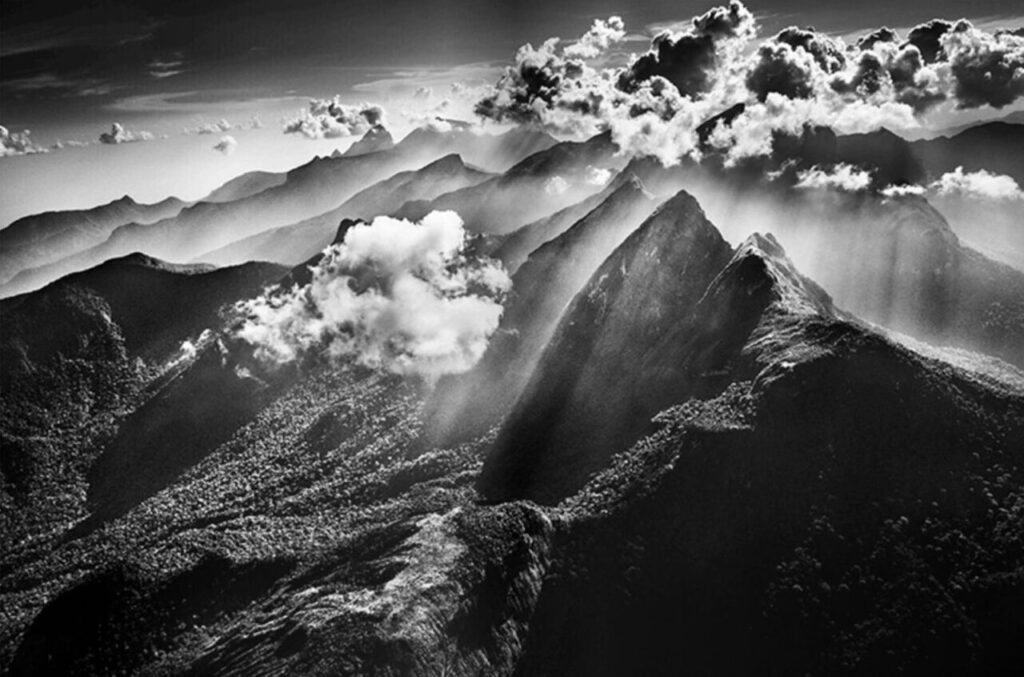“It’s like you just can’t look away!” I overheard a visitor exclaim as she moved to get a better look at one of the photos in the Edward Burtynsky & Sebastião Salgado exhibit at the Nicholas Metivier Gallery. It’s true, both Burtynsky’s and Salgado’s photos are captivating and present beautiful—if unsettling—images of the natural world.
Burtynsky and Salgado are long-time friends and colleagues, who have both spent their careers photographing the natural world. This exhibit features images from both of their newest series—three from Burtynsky’s series depicting the industrialization of Africa, and five from Salgado’s newest series Amazônia, portraying the landscapes and inhabitants of the Amazonian rainforest in Brazil. While Burtynsky’s prints are large, abstract, and burst with colour, Salgado’s smaller black and white prints draw viewers into ethereal landscapes and rituals of Indigenous communities.
Installation views with works by Edward Burtynsky (left) & Sebastião Salgado (right) at the Nicholas Metivier Gallery. Photo: Jennifer Boothby
Burtynsky is based in Toronto, but has travelled the world producing aerial images of human interventions in the landscape, namely infrastructure and resource extraction. His work is characterized by abstract aerial views, which are often brightly coloured, highly detailed, and employ an innovative use of scale. By portraying the landscape from above—photographing from helicopters, planes, or drones—Burtynsky is able to capture the large-scale impacts of human activity on the planet. At the same time, his images are incredibly detailed, and capture the minute textures of the landscape, which draw viewers in and ground the otherwise surreal photos.
Perhaps the most captivating aspect of Burtynsky’s work is the tension between the beauty of his photos, and the environmental destruction presented. The vibrant colours and textures that make his work so engaging are often results of mining and fossil fuel production, which makes his work somewhat unsettling.
This tension between visual beauty and environmental destruction is evident in Burtynsky’s striking Sulfur Springs #2, which shows a sulfur spring in Dallol, Ethiopia—one of the hottest locations on earth. On first glance, the print appears abstract—due to the aerial view and large scale—however, there is clearly an encounter between the natural and the unnatural. Viewers’ eyes are immediately drawn to the vibrant chemical hues of yellow, brown, and green, that seem to creep up from the bottom of the photo and encroach on the pristine blue water above. The vivid colours are as unsettling as they are beautiful. Specifically, the bright yellow colour—though likely due to salt and sulfur deposits—evokes toxicity and looks like a chemical spill bleeding into the water.
This print also features the incredible detail that characterizes much of Burtynsky’s work. Examining the photo up close, I was captivated by the lush visual textures. An intricate network of fissures run through the rock, and small rounded shapes, resembling coral, dance across the edges of the photo.
Edward Burtynsky, Sulfur Springs #2, Dallol, Danakil Depression, Ethiopia, 2018, pigment inkjet print on Kodak Professional Photo Paper, 48” x 64”. Courtesy of Nicholas Metivier Gallery
Likewise, Burtynsky’s Tailings Pond #2 balances the beauty of the landscape, with the destructive impacts of resource extraction. As the sole photo displayed on the north wall of the gallery, this is perhaps the most visually striking of Burtynsky’s three prints. It features the tailings pond of a diamond mine in South Africa, with alternating radial bands of grey and white, that splay out from the centre. On first glance, this image looks like an abstract painting, as different shades of grey and white swirl towards the outer edges, resembling paintbrush strokes or a pattern of marble veins. On closer examination, however, it is clear that the beautiful patterns in the landscape have resulted from damaging mining practices. Looking closely, viewers can see that the tailings—waste products of diamond mining— emanate from a small facility at the centre of the photo. The aerial view and framing truly convey the scale at which human activities impact the environment; the small facility at the centre has transformed the entire landscape.
Edward Burtynsky, Tailings Pond #2, Wesselton Diamond Mine, Kimberley, Northern Cape, South Africa, 2018, pigment inkjet print on Kodak Professional Photo Paper, 48” x 64”. Photo: Jennifer Boothby
Salgado’s photos, displayed on the east and south walls of the gallery, explore the natural world and its human inhabitants. Based in Paris, the Brazilian photographer produces black-and-white gelatin sliver prints of pristine landscapes and the communities that populate them. This exhibit features five photos from Salgado’s Amazônia series, which took six years to produce, during which Salgado settled for weeks at a time in different villages throughout the Brazilian Amazon, photographing the rainforest and its Indigenous people.
Although Salgado’s prints are smaller and more subdued than Burtynsky’s colourful works—they are no less striking in their impact. One of Salgado’s most significant photographs in the exhibit features a girl from Kampa do Rio Indigenous Territory, applying paint to her face while gazing into a hand-mirror. The image illustrates Salgado’s impressive use of light and framing. The stark black background and the girl’s plain black dress remove any context and emphasize the ritual of applying the paint. Viewers’ eyes are drawn directly to her illuminated face, and follow her concentrated gaze into her hand mirror.
Sebastião Salgado, Luísa, daughter of Moisés Piyãko Asháninka, paints herself in the mirror, Kampa do Rio Amônea Indigenous Territory, state of Acre, 2016, gelatin silver print, 24” x 20”. Courtesy of Nicholas Metivier Gallery
Salgado’s photos of human subjects posed against black backgrounds are juxtaposed with his exquisite photos of unrestrained landscape. Positioned right at the end of the exhibit, Marauiá mountain range depicts a series of rough mountain peaks that recede into the distance and reach up towards billowing clouds. Like Burtynsky’s work, this photo contains an incredible amount of detail that grounds the otherwise ethereal landscape. From up close, viewers can see individual light rays pouring through the clouds and emphasizing the rough texture of the mountains in the left foreground. Unlike Burtynsky’s work however, there is no evidence of human intervention in the mountain landscape. Rather, the mountains appear intact—outside the human epoch.
Sebastião Salgado, Marauiá mountain range, Yanomami Indigenous Territory, Municipality of São Gabriel da Cachoeira, state of Amazonas, 2018, gelatin silver print, 24” x 35”. Courtesy of Nicholas Metivier Gallery
Between the unsettling abstract beauty of Burtynsky’s works and the ethereal appearance of Salgado’s photos, this exhibit prompts us to contemplate human impacts on the landscape, and how we think about our relationships with the natural world.
Jennifer Boothby
*Exhibition information: Edward Burtynsky & Sebastião Salgado, November4 – 27, 2021, Nicholas Metivier Gallery, 190 Richmond Street East, Toronto. Gallery hours: Tue – Sat, 10 am – 6 pm.





